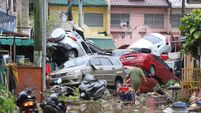N Korea backs away from threat of attack
The North’s gestures came after South Korea launched fighter jets, evacuated hundreds of residents near its land border with the North and sent residents of islands near disputed waters into underground bunkers in case Pyongyang followed through on its vow to attack over the drills.
“It appears that deterrence has been restored,” said Daniel Pinkston, Seoul- based analyst with the International Crisis Group think tank. “The North Koreans only understand force or show of force.”
This is not the first time the North has taken the international community down this road. The North has previously been accused of using a mix of aggression and conciliatory gestures to force international negotiations that usually net it much-needed aid.
Real progress, meanwhile, on efforts to rid the North of its nuclear weapons programmes has been rare.
Yesterday’s drills came nearly a month after the North shelled Yeonpyeong Island, a tiny enclave of fishing communities and military bases about 12km from North Korean shores, in response to an earlier round of South Korean live-fire manoeuvres.
The North Korean artillery barrage killed two marines and two construction workers in its first attack targeting civilian areas since the 1950-53 Korean War. Tensions between the two countries, still technically at war, soared.
They have remained in a tense stand-off since the November 23 attack, and an emergency meeting of UN diplomats in New York yesterday failed to find any solution to the crisis.
However, a high-profile American governor yesterday announced what he said were two nuclear concessions from the North.
New Mexico Governor Bill Richardson, a frequent unofficial envoy to North Korea and former US ambassador to the UN, said during his visit the North agreed to let UN atomic inspectors visit its main nuclear complex to make sure it is not producing enriched uranium for a nuclear bomb.
Mr Richardson also said that Pyongyang was willing to sell fresh fuel rods, potentially to South Korea.
North Korea called yesterday’s drills a “reckless military provocation” but said it was holding its fire because Seoul had changed its firing zones.
The official Korean Central News Agency carried a military statement that suggested the North viewed the drills differently to the ones that provoked it last month because South Korean shells landed farther south of the North’s shores.
The North claims the waters around Yeonpyeong as its territory, and during last month’s artillery exchange accused the South of firing artillery into its waters.














